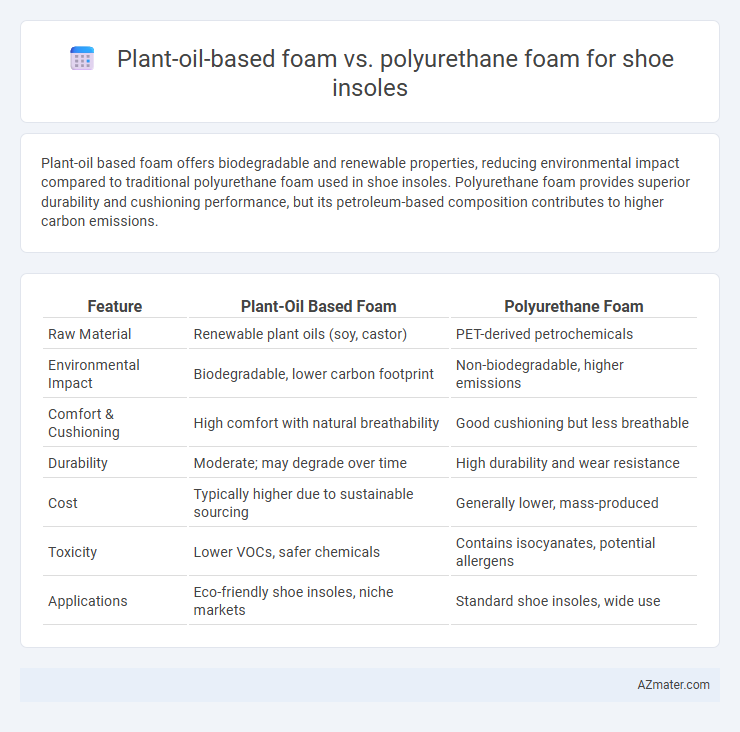Plant-oil based foam offers biodegradable and renewable properties, reducing environmental impact compared to traditional polyurethane foam used in shoe insoles. Polyurethane foam provides superior durability and cushioning performance, but its petroleum-based composition contributes to higher carbon emissions.
Table of Comparison
| Feature | Plant-Oil Based Foam | Polyurethane Foam |
|---|---|---|
| Raw Material | Renewable plant oils (soy, castor) | PET-derived petrochemicals |
| Environmental Impact | Biodegradable, lower carbon footprint | Non-biodegradable, higher emissions |
| Comfort & Cushioning | High comfort with natural breathability | Good cushioning but less breathable |
| Durability | Moderate; may degrade over time | High durability and wear resistance |
| Cost | Typically higher due to sustainable sourcing | Generally lower, mass-produced |
| Toxicity | Lower VOCs, safer chemicals | Contains isocyanates, potential allergens |
| Applications | Eco-friendly shoe insoles, niche markets | Standard shoe insoles, wide use |
Introduction to Shoe Insole Materials
Plant-oil based foams, derived from renewable resources such as soybean or castor oil, offer eco-friendly alternatives to traditional polyurethane foams used in shoe insoles. These bio-based foams provide comparable cushioning, durability, and flexibility while reducing reliance on petroleum-based chemicals and lowering carbon footprints. Advances in plant-oil foam formulation enable customization of density and resilience, enhancing comfort and support in footwear applications.
What is Polyurethane Foam?
Polyurethane foam is a versatile synthetic material widely used in shoe insoles for its excellent cushioning, durability, and shock absorption properties. It is produced through the chemical reaction of polyols and diisocyanates, resulting in a lightweight, resilient foam that provides effective support and comfort during prolonged wear. Compared to plant-oil based foams, polyurethane foam typically offers higher density and enhanced resistance to compression set, making it a preferred choice for high-performance footwear applications.
Overview of Plant-Oil Based Foams
Plant-oil based foams for shoe insoles are derived from renewable resources such as soybean, castor, or palm oil, offering a sustainable alternative to traditional polyurethane foams. These bio-based foams exhibit comparable cushioning, durability, and flexibility while reducing carbon footprint and reliance on fossil fuels. Enhanced breathability and natural odor resistance are additional benefits, making them increasingly popular in eco-conscious footwear manufacturing.
Environmental Impact: Plant-Oil vs Polyurethane
Plant-oil based foam insoles significantly reduce carbon footprint by utilizing renewable resources like soybean or castor oil, resulting in lower greenhouse gas emissions during production. Polyurethane foam, derived from petroleum-based chemicals, contributes to higher environmental pollution and non-biodegradability, exacerbating landfill waste. Plant-based foams often incorporate biodegradable properties and consume less energy in manufacturing, making them a sustainable alternative to conventional polyurethane insoles for eco-conscious footwear.
Comfort and Performance Comparison
Plant-oil based foam insoles offer superior breathability and natural moisture-wicking properties, which enhance comfort by reducing foot sweat and odor compared to traditional polyurethane foam. Polyurethane foam provides excellent cushioning and durability, maintaining consistent support under high-impact activities, but tends to retain heat and moisture, potentially causing discomfort over prolonged wear. The performance of plant-oil based foams is improving with advancements in bio-polymer technology, making them a sustainable alternative that balances eco-friendliness with adequate shock absorption and resilience for everyday footwear.
Durability and Longevity
Plant-oil-based foam insoles offer enhanced environmental benefits and comparable comfort, but polyurethane foam insoles typically provide superior durability and longevity due to their denser cellular structure and resistance to compression. Polyurethane's resilience against wear and deformation ensures prolonged support, making it ideal for high-impact activities and long-term use. Advancements in bio-based polyurethane foams are narrowing the gap, integrating plant oils to maintain durability while improving sustainability.
Breathability and Moisture Management
Plant-oil based foam insoles offer superior breathability compared to traditional polyurethane foam, enabling better air circulation and reducing foot sweat accumulation. These bio-based foams inherently manage moisture by wicking away sweat and allowing faster evaporation, which helps maintain foot dryness and comfort. In contrast, polyurethane foam tends to trap moisture, leading to increased odor and reduced insole lifespan due to prolonged dampness.
Cost and Supply Chain Considerations
Plant-oil based foam for shoe insoles offers a cost advantage due to renewable raw materials and potential for price stability amid fossil fuel market fluctuations. Polyurethane foam relies on petroleum derivatives, subjecting it to higher volatility in pricing and supply chain disruptions associated with oil markets. The supply chain for plant-oil foam benefits from agricultural scalability, whereas polyurethane foam is dependent on petrochemical refining infrastructure, impacting sourcing reliability and sustainability metrics.
Innovations and Future Trends
Plant-oil based foam for shoe insoles demonstrates significant innovation by utilizing renewable resources such as soy and castor oils, which reduce carbon footprint and enhance biodegradability compared to traditional polyurethane foam. Advances in bio-polymer chemistry have improved the durability, flexibility, and cushioning performance of plant-based foams, making them competitive with conventional polyurethane materials. Future trends indicate a growing shift towards hybrid foams that combine bio-based components with engineered polyurethane to optimize comfort, sustainability, and cost-effectiveness in footwear applications.
Which Insole Foam is Better for You?
Plant-oil based foam insoles offer eco-friendly, biodegradable benefits and enhanced breathability, making them ideal for individuals seeking sustainable and hypoallergenic footwear options. Polyurethane foam insoles provide superior cushioning, durability, and support, catering to those who prioritize long-lasting comfort and impact absorption during high-performance activities. Choosing the better insole foam depends on your preference for environmental impact versus maximum comfort and resilience in daily wear.

Infographic: Plant-oil based foam vs Polyurethane foam for Shoe insole
 azmater.com
azmater.com